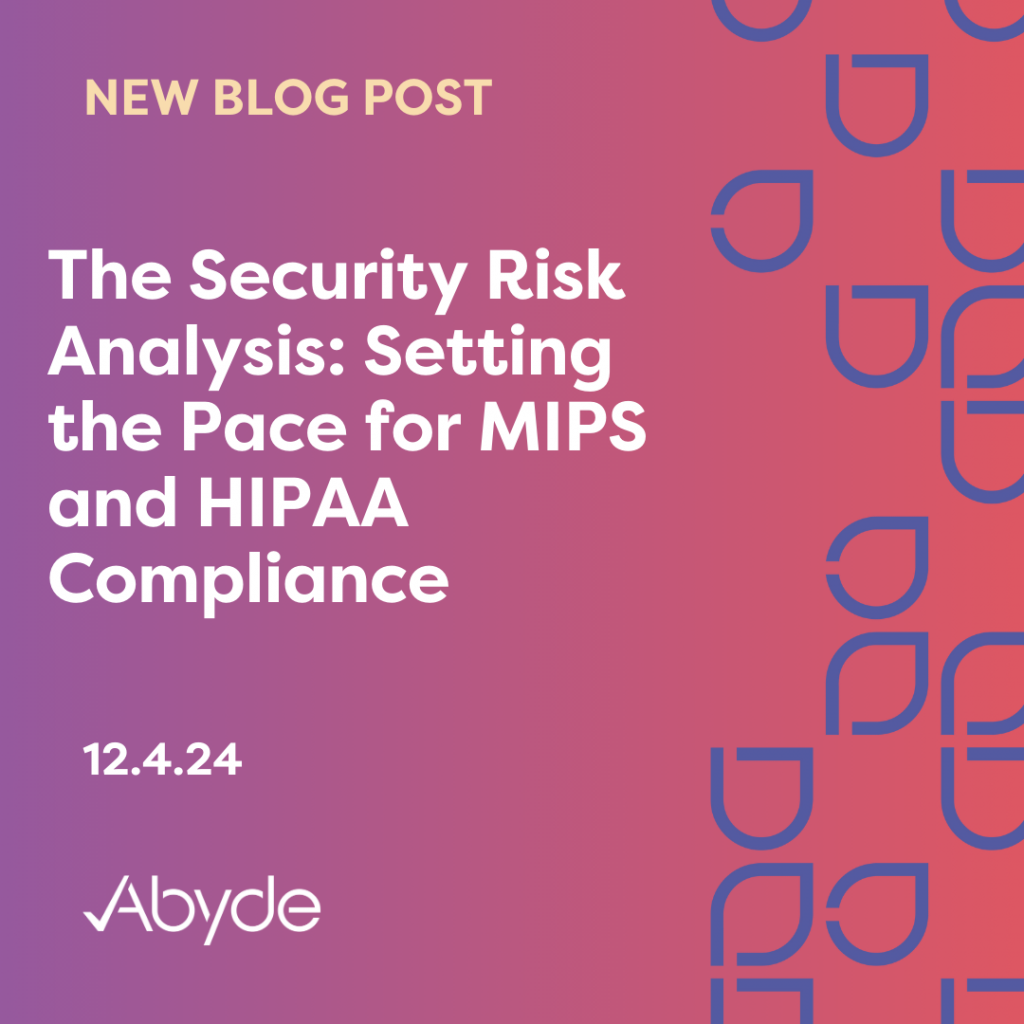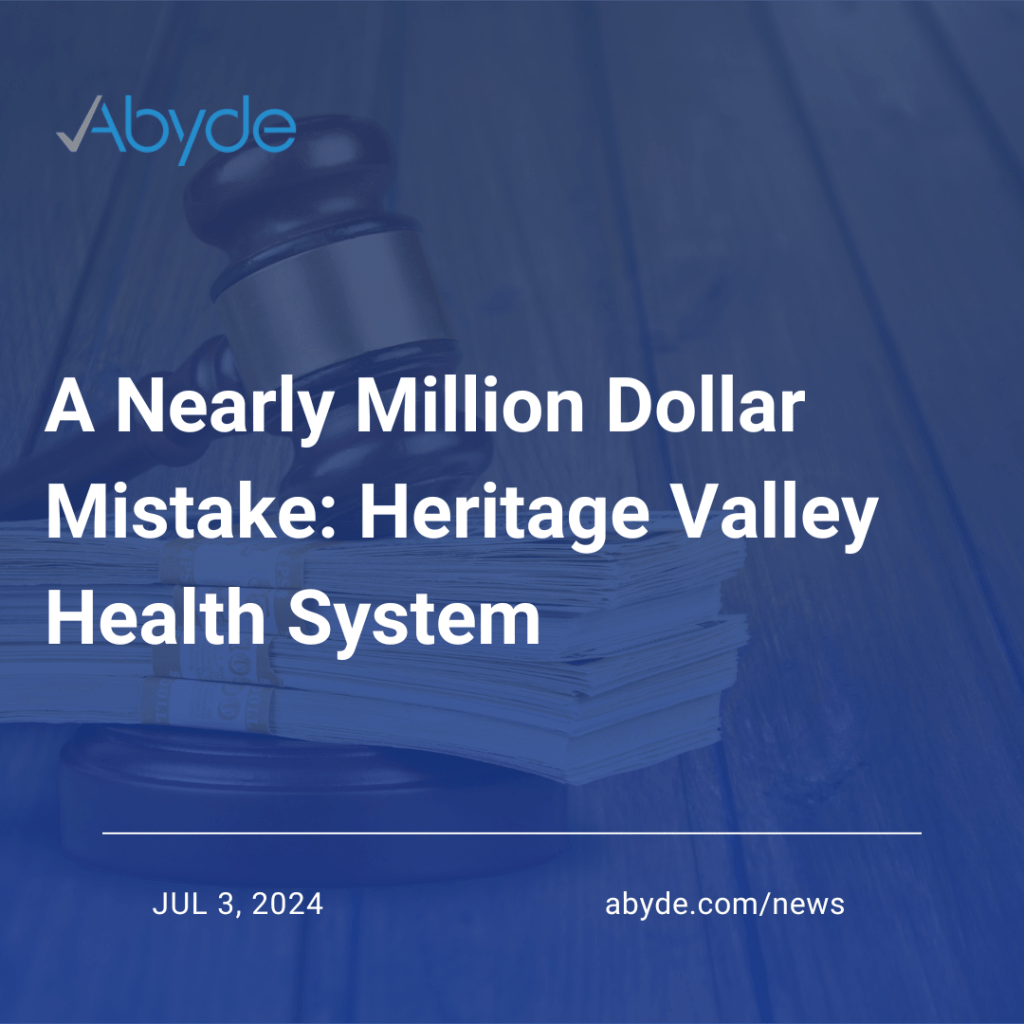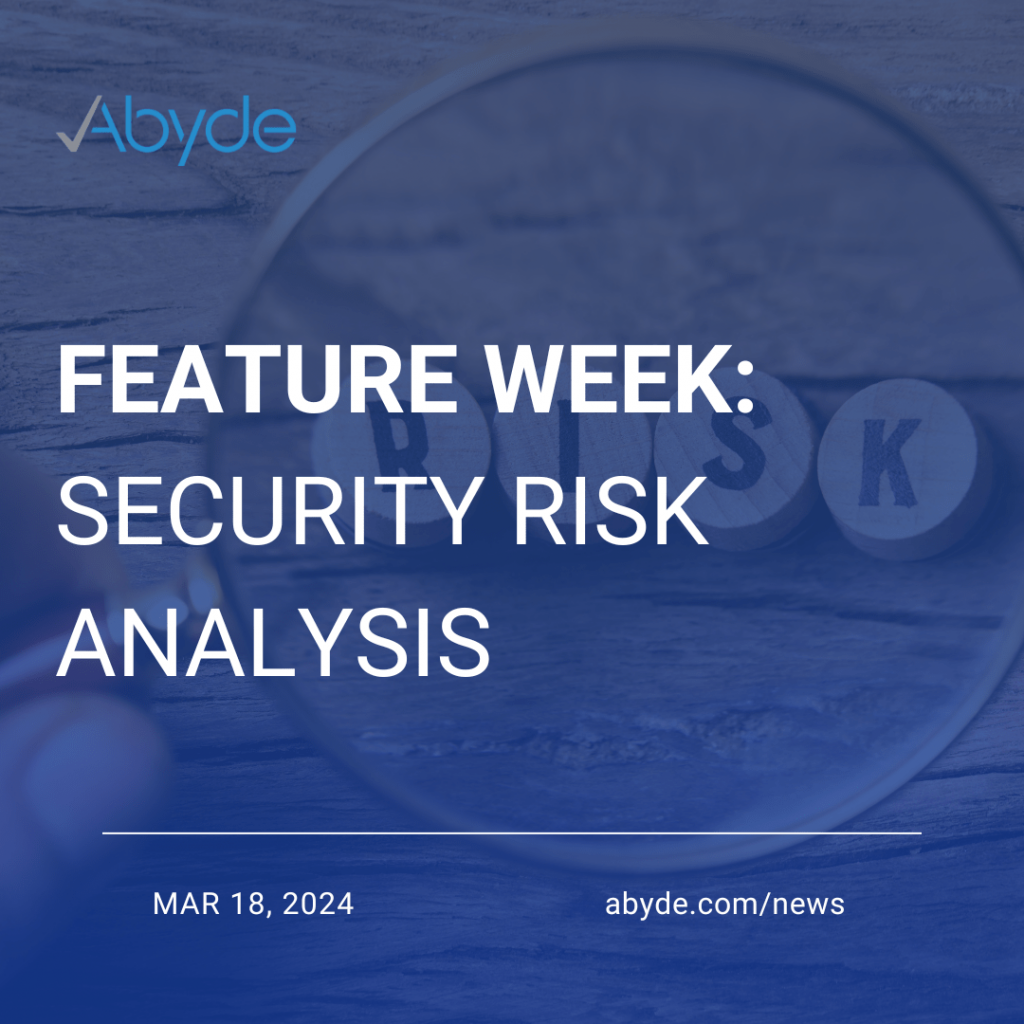December 17, 2024 Keeping all locations in line with HIPAA regulations can be quite a challenge, especially when managing a multi-location practice. It’s a complex puzzle that requires careful attention to detail and a proactive approach to ensure compliance across the board. And we hate to break it to you, but a blanket Security Risk Analysis for your organization isn’t enough. A Security Risk Analysis, or SRA, is a thorough review of your organization’s physical, administrative, and technical safeguards to protect patient data. Even when you’re managing compliance at a single location within a multi-location organization, you are responsible for ensuring an SRA is completed for your location. The Office for Civil Rights (OCR) is serious about this requirement, as indicated by a recent significant fine. A penalty of over $500,000 was recently announced for the Children’s Hospital of Colorado system. While this investigation was sparked by a phishing attack, one of the major findings was missing SRAs for all locations. Completing this SRA is imperative. As the OCR spearheads new enforcement and initiatives, it’s time to get compliant. What is a SRA? The SRA is an in-depth review of everything your practice does to ensure patient data is safe. This means everything from whether your practice utilizes alarms and codes on doors to the servers you use and even how your staff handles patient intake, like how the sign-in sheet process works. The SRA is the first step of a compliant practice because it allows you to review your vulnerabilities and make changes to uphold your commitment to keeping data safe. The SRA is also a requirement for MIPS. Unfortunately, the SRA is a commonly missed requirement for medical practices. In fact, 86% of all practices could not show an adequate SRA in the last round of random HIPAA audits. Completing a sufficient Security Risk Assessment (SRA) is essential for maintaining a compliant medical practice. This process is closely linked to the Office for Civil Rights (OCR) Risk Analysis Initiative, which mandates that medical practices and organizations carry out this required assessment. Recently, the Bryan County Ambulance Authority was fined $90,000 for failing to conduct an SRA, marking the first enforcement action under this new initiative. This incident demonstrates the OCR’s commitment to this initiative and its dedication of resources to ensure compliance. Importance of Location-Specific SRAs When conducting a SRA, assessing every location within your organization is vital. While performing a single SRA for the entire entity might seem easier, compliance is more intricate and requires ongoing attention rather than being a one-off endeavor. Each location has distinct vulnerabilities that must be acknowledged and addressed. For instance, one location might have different vendors than another, and another location might be in an older building, with different security to keep Protected Health Information (PHI) safe. Although some overarching requirements may come from the main location, capturing each site’s specific conditions is essential. This thorough documentation demonstrates that every location takes compliance seriously, addresses vulnerabilities, and keeps patient data safe. How to Complete an SRA With the right resources, managing and completing an SRA for a multi-location practice can be simplified. Organization is key: ensuring each location completes all SRAs and can be easily accessed in a centralized location. Your organization can efficiently complete this requirement by having a tailored set of questions for each location. To learn more about streamlining your multi-location SRAs for your organization, schedule a consultation with a HIPAA expert today.
The Security Risk Analysis: Setting the Pace for MIPS and HIPAA Compliance
December 4, 2024 As a healthcare provider, tackling your daily to-do list probably feels like running a marathon without a finish line at times. You’re tasked with managing a successful business, keeping up with ever-changing legislation and new technology while ensuring that your top priority of patient care never falls behind. Despite the challenging course, there’s a benefit to keeping pace with both quantity and quality. Providers are rewarded for going the extra mile thanks to Value-Based payment programs like MIPS and other government incentives like the HIPAA Safe Harbor Law. What is MIPS? You’ve most likely heard of the Merit-based Incentive Payment System (MIPS) and might already be a participant in it. Whether it’s a Quality Payment Program or new legislation passed into law, the government continually emphasizes the importance of being proactive rather than reactive and providing incentives for doing so. This is why it’s valuable to know whether your organization is eligible to participate in government programs (you can check here). Many of these different program requirements align with the standards your practice already has to meet under HIPAA law—protecting your patients, checking off compliance requirements, and receiving incentives can often be done all in one stride. To take a quick step back, MIPS is one of two payment tracks under the Medicare Quality Payment Program. The Centers for Medicare and Medicaid Services (CMS) uses this system to measure eligible clinician performance and reward high-value, low-cost care. MIPS participants can receive a payment adjustment to their Medicare reimbursements based on their performance scores across four different categories: Quality: The type of care you deliver based on specific measures of performance. Promoting Interoperability: Focuses on patient engagement and electronic exchange of information using Electronic Health Record (EHR) technology to improve patient access to their health information and exchange of information between providers. Improvement Activities: Your participation in clinical activities that work towards improving care coordination and patient engagement and safety. Cost: Assesses the cost of care you provide in relation to your Medicare claims. The Importance of the Security Risk Analysis (SRA) Before you can engage with the various performance measures, you must first meet a prerequisite for participating in the MIPS Promoting Interoperability performance category. This requirement is crucial not only for achieving HIPAA compliance but also for benefiting from other government incentives: the Security Risk Analysis (SRA). Conducting an SRA involves evaluating any potential risks to your organization’s electronic Protected Health Information (ePHI) and implementing necessary security updates and safeguards to address any identified vulnerabilities. Your organization must complete an SRA at least once a year to comply with MIPS and HIPAA standards. Additionally, it’s important to review and update the assessment regularly throughout the year to reflect any changes in your processes. Getting Compliant for MIPS Beginning your compliance journey can be overwhelming, but it is essential to take advantage of government initiatives such as MIPS. Intelligent software solutions can help keep your practice on track by outlining the requirements for HIPAA compliance and offering a streamlined SRA that meets MIPS standards. To learn more about how to become compliant for MIPS, schedule a meeting with a compliance expert today.
A Nearly Million Dollar Mistake: Heritage Valley Health System
July 3, 2024 Did you know that ransomware attacks are becoming increasingly common in healthcare? Since 2018, there has been a whopping 264% increase in large ransomware breaches. The devastating impact of a ransomware breach on an organization is wide-reaching, regardless of its size, as seen with the Change Healthcare breach. It’s imperative to take the proper precautions to ensure that Protected Health Information (PHI) is secure against hacking attempts. At the center of the latest fine, Heritage Valley Health System (HVHS), which operates in Pennsylvania, Ohio, and West Virginia, fell victim to ransomware attacks. These attacks infected HVHS systems, affecting sensitive patient information. As the Office for Civil Rights (OCR) reviewed the major data breach, several pieces of required documentation, such as a Security Risk Analysis (SRA) and an emergency plan, were absent. This missing documentation has led to a $950,000 fine and three years of corrective monitoring. Let’s explore what you can do to prevent this nearly million-dollar mistake. Importance of an SRA The purpose of the SRA is to review your risks and vulnerabilities regarding the management of ePHI (electronic Protected Health Information). This comprehensive analysis notes the physical, technical, and administrative controls to protect your patient’s PHI. Your SRA is documented proof that your organization understands its weaknesses and is making strides to address them and better protect patient data. While the SRA is a very important document, it is frequently missed. From the last round of random HIPAA audits, which have resumed recently, only 83% of practices and Business Associates could produce a sufficient SRA. SRAs are vital for practice compliance, showcasing growth, and best practices in safeguarding patient data. Check out our recent blog post here to learn more about the SRA. Why do I need plans in place? When running a medical practice, it’s important to be prepared for any situation that could arise. That’s why policies and procedures are so important. If your practice faces a scenario that may compromise PHI, your team needs easy access to a plan for handling the situation calmly. By addressing potential challenges well in advance, your team will feel empowered and confident in their ability to respond. Moreover, as part of your preventive measures, it’s beneficial to designate specific roles and responsibilities for your staff. This ensures that everyone is aware of their duties in any given situation. Cybersecurity Measures Unfortunately, healthcare practices have become very common victims of ransomware attacks. To prepare your organization for this, follow best cybersecurity practices, such as encryption, reviewing access controls, and creating unique sign-ons for all employees. Healthcare organizations should prioritize technical safeguards like encryption, access controls, and multi-factor authentication. However, security goes beyond technology. Implement security awareness training for staff, establish a data breach response plan, and maintain regular backups. Regularly conduct risk assessments and evaluate the security practices of third-party vendors. It’s important to consider partnering with an IT company offering valuable expertise. They can recommend the right tools, update you on evolving threats, and monitor your systems for suspicious activity. This layered approach will strengthen your systems and prepare you for potential attacks. How Smart Software Can Help Fines for HIPAA non-compliance can be staggering, but there are alternatives to the manual tracking and paper binders you may be used to. Intelligent software systems are designed to save you time and headaches and ultimately protect your practice to avoid audits and fines. Software empowers your team to manage your program easily and enables a culture of compliance in the office. It streamlines commonly overlooked requirements such as the SRA with dynamically created documentation and develops comprehensive plans, policies, and procedures so you stay current with the latest requirements. Better yet, when using cloud-based software solutions, you get 24/7 secure access and real-time updates when compliance regulations change. Schedule an educational consultation today to learn more about how software solutions can protect your practice.
HIPAA Audits are Back: 86% of Practices Miss This Crucial Requirement (And How to Fix It)
May 29, 2024 The random HIPAA audits are officially back. Melanie Fontes Rainer, Director of the Office for Civil Rights (OCR), confirmed in a recent interview that the OCR is proactively conducting audits as part of a series of improvements. Following a five-year hiatus from proactive audits, the Office for Civil Rights (OCR) has been updating key HIPAA regulations. For instance, the OCR is also releasing an updated Security Rule by the end of the year to better reflect innovation since its original publication over twenty years ago. As the OCR continues to advance HIPAA rules, it’s vital to be prepared with a foundation of a compliant practice. At the base of this foundation is the Security Risk Analysis (SRA), a commonly missing HIPAA requirement. During the last round of proactive audits, 86% of Covered Entities could not show a properly documented SRA for their practice. What is a Security Risk Analysis (SRA)? The OCR defines an SRA as “an accurate and thorough assessment of potential risks and vulnerabilities to confidentiality, integrity, and availability of electronic Protected Health Information (ePHI).” The SRA is focused on protecting ePHI. It is a continuous requirement and needs to be updated when significant changes occur to your practice. It’s best practice to complete the SRA at least annually. An SRA is a complete evaluation of how PHI is protected. Questions include encryption practices, staff training, disposal of PHI, and more. Why is the SRA Important? The SRA documents proof that a practice has appropriate safeguards to protect sensitive patient data. It requires practices to conduct self-audits and identify risks and vulnerabilities before they become issues. This means anticipating vulnerabilities and implementing preventative measures before sensitive data is compromised. If followed correctly, the SRA acts as a vital line of defense, helping prevent data breaches, ensuring patient privacy, and building trust within the healthcare system. How do I complete an SRA? Completing an SRA is crucial for protecting sensitive patient data. The good news is that several approaches are available, each with varying costs and timelines. Before starting an SRA, it is essential to have an HCO, or HIPAA Compliance Officer, in place to manage HIPAA documentation and the SRA process. You can complete the SRA internally using online resources provided by the OCR. While there are free resources, this option is less intuitive than others, can be time-intensive, and requires significant team effort. Manual audits can take weeks to months to complete. You could also hire an external auditor or consultant to complete your SRA. Hiring a consultant might reduce the burden on your team but can be costly. The average price of an external auditor is in the thousands, with some costing upwards of $20,000. Additionally, these external audits can take months. An alternative option is intelligent compliance software, which provides significant benefits for meeting the SRA requirement and more. It allows you and your practice to navigate the SRA cost-effectively and efficiently. While a manual audit usually takes weeks to months, an audit assisted by software can be completed in significantly less time, simplifying the SRA process, and saving your practice substantial costs and assuring protection. Why Should I Use Compliance Software? As the Security Rule is updated, your compliance program also deserves an upgrade. Intelligent software solutions can help you easily fulfill complex HIPAA requirements, prepare for potential risks and vulnerabilities, and protect patient data. Many organizations overlook the SRA, but software solutions can streamline the process and protect your practice. To learn more about Abyde’s innovative software solutions, schedule an educational consultation.
Abyde Feature Week: Scorecard
March 19, 2024 Welcome to Feature Week! Whether you stayed tuned from last week, or are a first-time reader, we are celebrating the features that Abyde offers to make it easy for your practice to stay compliant. Yesterday, we highlighted Abyde’s state-of-the-art Security Risk Analysis (SRA), turning a complicated evaluation of your business’s compliance practices into a simple questionnaire that can be completed in minutes. Once your SRA is done, the Scorecard comes into play. Get comfortable and stay tuned on how this feature can make HIPAA a breeze for your business. Keeping Score Whew!, That SRA wasn’t so bad, right? So, what’s next? This isn’t a scorecard like in golf but is a hole-in-one when it comes to monitoring your compliance practices. The Scorecard is a review of your answers to the SRA and gives your business a thorough explanation of how your current practices hold up against regulations, and what your organization can do to improve. The SRA is like a coach’s playbook, outlining the game plan for HIPAA compliance. The Scorecard is this plan in action, like reviewing your game tape, seeing what you need to improve and what vulnerabilities you have as a business. This scorecard is easy to review and gives your business the risk levels of your current practices. Each question is unique, and some practices are more critical than others. For instance, only changing your password every six months is not ideal, but not as risky as not encrypting your files. Unfortunately, some practices will never be ‘low risk’, even if they are not wrong just because there’s always the chance of human and technological errors. For instance, numerous employees working remotely while handling Protected Health Information (PHI) is always going to be riskier than all PHI staying in one location. Impacted by a breach? You can easily show proof of a Security Risk Analysis by downloading the Scorecard in the software, showing the government that you take HIPAA seriously. You can also see every version of your Scorecard in the software, seeing how your path to compliance has gotten easier with the help of Abyde. Ready to keep your HIPAA compliance score? Reach out to info@abyde.com and schedule a demo here for your business.
Abyde Feature Week: Security Risk Analysis
March 18, 2024 For some, this might be Spring Break, but we have something even more exciting planned: Feature Week! Throughout this week, we are going to share the amazing things we have to offer Business Associates (BAs) for HIPAA compliance. I know that Spring Break and software features might seem like worlds apart, but somehow at Abyde, we make compliance and simplicity go hand in hand. So, get comfortable, fix your beach chair, grab a drink, and see how Abyde can make your compliance journey easy with our Security Risk Analysis (SRA). What is a Security Risk Analysis (SRA)? A Security Risk Analysis (SRA) is a required assessment of risks and vulnerabilities of how Protected Health Information (PHI) is handled. The quick 411– PHI is identifiable information about a patient, like a social security number, medical records and more. The Security Risk Analysis, established in the Security Rule, is an overall evaluation of how your business properly protects PHI, ranging from how often you change the passwords on your systems, to security alarms on the door of the business. This assessment is required, and organizations’ lack of one is a common HIPAA violation. Last year, a BA was fined $100,000 by the Office of Civil Rights (OCR) after they were impacted by a ransomware attack. One of the first things the OCR looks for is an SRA. As you might’ve guessed, there was no SRA in place, contributing to the hefty fine. How Abyde can help There’s A LOT of information to go through, and it might be overwhelming. That’s where our simplified Security Risk Analysis comes in. With Abyde, you can now analyze your processes without needing to hire a consultant or trying to audit yourself by referring to tons of paperwork. Before Abyde, an SRA could take weeks. With Abyde, it takes minutes. Our simple questions get straight to the point, and if you don’t know the answer to something? Don’t worry! You can mark the question and it will come back up later in our Ongoing Questions section on the dashboard, or call our team of compliance experts for help. Abyde is here to make compliance simple. It’s what we do best. Stay tuned for the next day in our feature week: our Scorecard. To learn more about the features of the Abyde software, email us at info@abyde.com and see the software in action by scheduling a demo here for Business Associates and here for Covered Entities.
SR-Hey, Have You Conducted a Security Risk Analysis?
July 28, 2023 In the ever-evolving landscape of healthcare, the safeguarding of sensitive patient information is of paramount importance. To protect patient privacy and maintain health data integrity, the Health Insurance Portability and Accountability Act (HIPAA) sets stringent standards for compliance. One of the vital components in achieving HIPAA compliance is conducting Security Risk Analyses (SRAs). Understanding HIPAA and its Compliance Requirements HIPAA, enacted in 1996, is a landmark piece of legislation designed to protect the privacy and security of patients’ health information. The regulation establishes a set of rules that healthcare providers, health plans, and other covered entities must follow to ensure the confidentiality and integrity of patients’ protected health information (PHI). Failure to comply with HIPAA can lead to severe consequences, including hefty fines and reputational damage. But we all knew that, right? What is a Security Risk Analysis (SRA)? Now this is what we need to know! A Security Risk Analysis systematically evaluates an organization’s information technology infrastructure, policies, and procedures to identify potential vulnerabilities and risks to the confidentiality, integrity, and availability of PHI. An SRA aims to assess the organization’s current security measures, identify weaknesses, and implement necessary safeguards to mitigate risks effectively. Why is an SRA Important for HIPAA Compliance? Identifying Vulnerabilities: An SRA helps healthcare organizations identify potential vulnerabilities in their systems and processes that could lead to unauthorized access or disclosure of PHI. By understanding these weaknesses, organizations can take proactive measures to address them before any security breach occurs. Preventing Data Breaches: Data breaches in healthcare can expose sensitive patient information, leading to significant legal and financial consequences. Conducting an SRA helps preemptively prevent data breaches by bolstering security measures and ensuring compliance with HIPAA’s Security Rule. Mitigating Risks: Risks in healthcare are constantly evolving due to new cybersecurity threats and technological advancements. Regular SRAs allow organizations to stay ahead of potential risks and adopt measures to mitigate them effectively. Tailoring Security Measures: Each healthcare organization has unique systems and processes. An SRA helps identify specific security needs and allows the organization to tailor security measures to address its individual risks effectively. Demonstrating Compliance: HIPAA compliance requires organizations to conduct regular SRAs. By documenting assessments, organizations can demonstrate their commitment to safeguarding patient data, which is essential during audits and investigations. Improving Security Posture: SRAs are not just a checkbox exercise; they provide valuable insights into the organization’s overall security posture. Based on the analysis results, organizations can continually implement improvements to enhance their security measures. Legal and Reputational Protection: A data breach can tarnish an organization’s reputation and erode patient trust. By conducting SRAs and implementing robust security measures, healthcare entities can enhance their legal and reputational protection. At Abyde, we take a distinctive approach to SRAs by offering a personalized and tailored experience for you and your practice. Think of our SRA module as your dedicated companion, guiding you through the process of identifying vulnerabilities specific to your practice. Recognizing that each practice is unique, our intuitive software will present only the questions relevant to your business as you respond. This streamlined approach is one of the many ways we ensure simplicity and effectiveness in achieving your compliance goals. The protection of patient data is not only a legal obligation but also an ethical responsibility for healthcare organizations. HIPAA compliance is critical in ensuring that patient information remains secure and confidential. Regular SRAs are an indispensable aspect of HIPAA compliance, allowing organizations to identify vulnerabilities, prevent data breaches, and mitigate risks effectively. By investing in security measures and staying proactive in their approach, healthcare organizations can reinforce patient trust and safeguard the integrity of their services in today’s increasingly digital healthcare landscape.
The Security Risk Analysis and its Many Misconceptions
August 13, 2021 HIPAA is kind of like a puzzle – without having each and every individual requirement in place, your practice can’t consider itself fully compliant. But much like building a jigsaw blindfolded, it’s a lot harder to piece together the big picture of compliance with all of the misconceptions out there masking what HIPAA’s requirements actually entail. Now, the first piece in this so-called “HIPAA puzzle” is the Security Risk Analysis (SRA) which requires all covered entities to assess any potential risks and vulnerabilities to protected health information (PHI) based on the physical, technical, and administrative safeguards that their organization has in place. It’s essentially just a self-evaluation that helps lay the groundwork for a complete HIPAA program AND is the first thing a practice will be asked to provide in the case of an audit. But despite its importance, only 14% of entities actually fulfill the requirement – so what is causing this lack of compliance and why does the SRA seem like an unsolvable puzzle in itself? A large piece of the widespread noncompliance is all of the confusion that surrounds the ‘what, why, and how’ of the SRA. This is why in order to ensure all organizations know how to complete the first part of the big HIPAA puzzle, we need to break down the myths vs the facts. Myth #1: Small practices and independent providers don’t need to worry about the SRA. False: All providers, no matter the size or specialty, are covered entities under HIPAA and are therefore obligated to perform a risk analysis along with all other requirements under HIPAA law. Myth #2: My Electronic Health Record (EHR) takes care of privacy and security, so I don’t need to complete an SRA. False: Even with a certified EHR, the risk analysis isn’t completed for you. The EHR vendor may provide information and training on the privacy and security aspects of their product but they are not responsible for privacy and security compliance within your practice. Additionally, an SRA involves all PHI within your organization, including what isn’t housed in your EHR like paper records and files. Myth #3: My IT company handles a full SRA. False: Similar to the confusion around your organization’s EHR, IT companies might help to assess technical safeguards and identify technical risks – but do not provide a comprehensive analysis of all aspects of your organization to cover the administrative and physical requirements. Myth #4: I can use a templated checklist to complete my SRA. False: While the government does provide some tools that can be used as helpful guidance for conducting an SRA, in order for the analysis to meet the requirements it must assess specific elements of your organization and practice operations which may differ from the types of things assessed in a template or generic checklist. Myth #5: The SRA is a one-time thing and as long as I completed it once, I’m good to go! False: The HIPAA Security Rule specifically states, “the risk analysis should be an ongoing process, in which a covered entity regularly reviews its records to track access to e-PHI and detect security incidents, periodically evaluates the effectiveness of security measures put in place, and regularly reevaluates potential risks to e-PHI.” But although, your organization does need to be conducting an SRA on a continual basis – this doesn’t mean that each year you’ll need to start over from scratch. It’s important (and required) that you update your SRA annually at the very least as well as any time there are changes to your practice or systems to identify any changes in risks and maintain the necessary safeguards within your organization. While we hope our little game of “myth busters” helped clarify any confusion around what goes into completing this requirement and why it’s so important, we know that it might’ve also caused some concern for how a small, independent practice is supposed to tackle all of this alone. Completing a comprehensive analysis (on an ongoing basis) along with the proper documentation and risk mitigation that’s required involves time, resources, and expertise that might seem unfeasible to a small or medium-sized organization. But luckily there are outside resources available to help debunk the other misconception that completing an SRA HAS to be challenging. So while your practice can tackle this requirement DIY-style, a software solution like Abyde makes it so you don’t have to – providing all the tools and support to guide you through the misconceptions and help to put the pieces into place so that your practice can easily complete the puzzle of HIPAA compliance. Schedule a one-on-one consultation today to see where your practice currently stands and how Abyde makes meeting the SRA – and all other HIPAA requirements – a breeze!
So, What Exactly is a Security Risk Analysis?
June 2, 2020 You might be aware that all practices need to complete a ‘Security Risk Analysis’ as a part of their HIPAA compliance program, but do you know exactly what this analysis covers? While this is the first step and among the most important aspects of a complete HIPAA program, it is often missed or not properly completed – in fact, during the latest round of OCR audits, 86% of covered entities could not show a properly documented Security Risk Analysis for their practice. The HIPAA Security Rule defines a Security Risk Analysis (SRA) as an “accurate and thorough assessment of the potential risks and vulnerabilities to the confidentiality, integrity, and availability of electronically protected health information held by the covered entity or business associate.” In layman’s terms, the risk analysis is a systematic review of your processes and policies that is ultimately designed to shed light on any aspects of your practice that could be considered weaknesses in protecting the privacy and security of your practice and the protected health information (PHI) it holds. Not having a properly documented analysis leaves potential risks unidentified and is a huge red flag for your overall compliance efforts. What questions does an SRA need to include? There is no specific checklist to follow when it comes to performing a risk analysis for your practice. The OCR does however provide specific elements that should be included. Your assessment should: Completing a risk analysis for your organization is not just a one-time thing. Assessments should be reviewed periodically, especially as new work processes are implemented or technologies are updated. After events such as COVID-19, addressing any changes your practice made regarding remote operations, utilizing telehealth services, or receiving/providing more information electronically rather than in a physical exchange are all things that will need to be addressed for any additional vulnerabilities or threats they brought on. What’s the best way to tackle an SRA? If your organization hasn’t completed an SRA before or has done so in a more basic or incomplete manner, using an outside organization will help to ensure all areas of the SRA are fully completed and documented accordingly. A third party can also help add new areas and questions to the SRA that reflect changing regulations as well as technology enhancements that present new threats or vulnerabilities to your organization.








